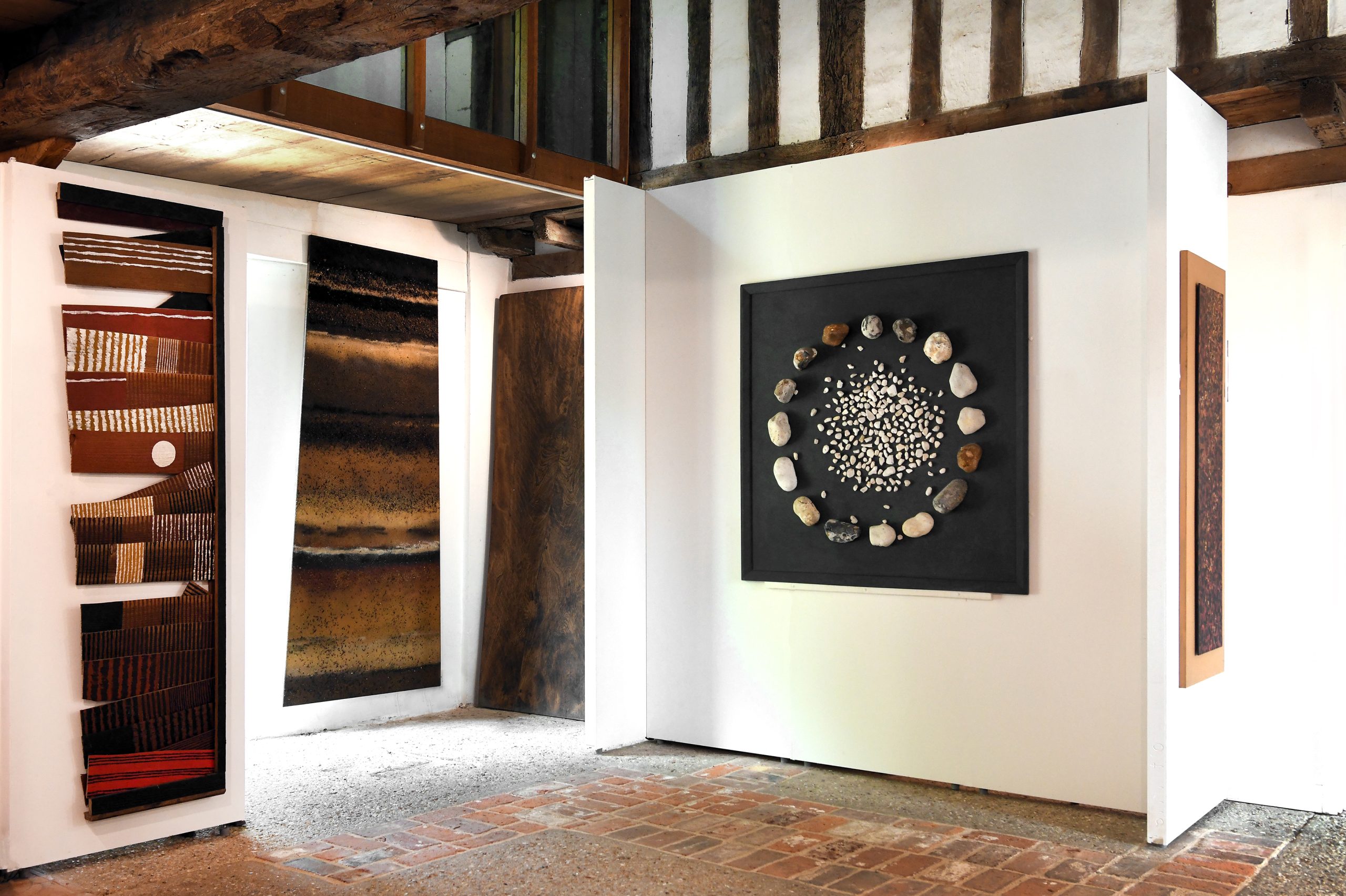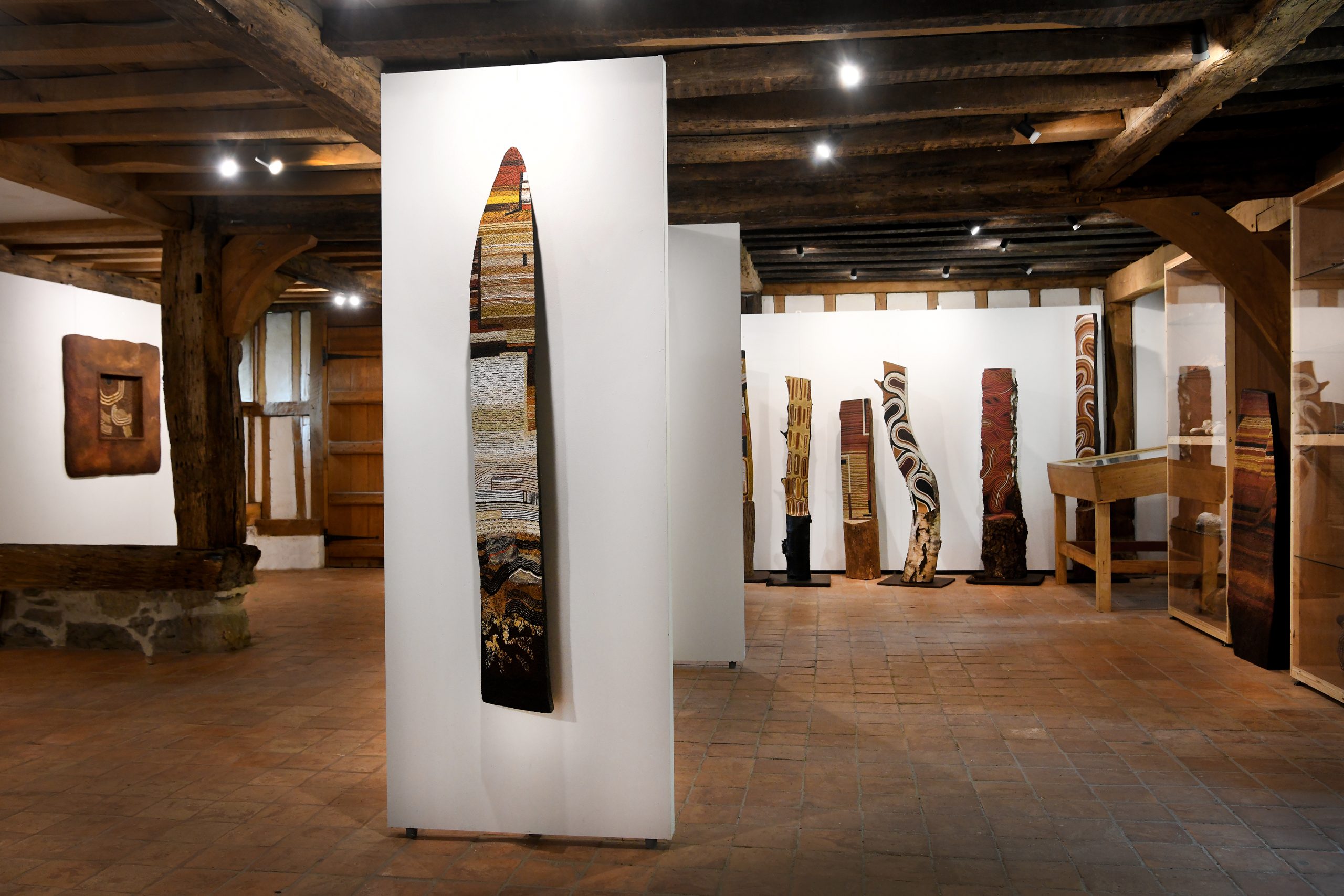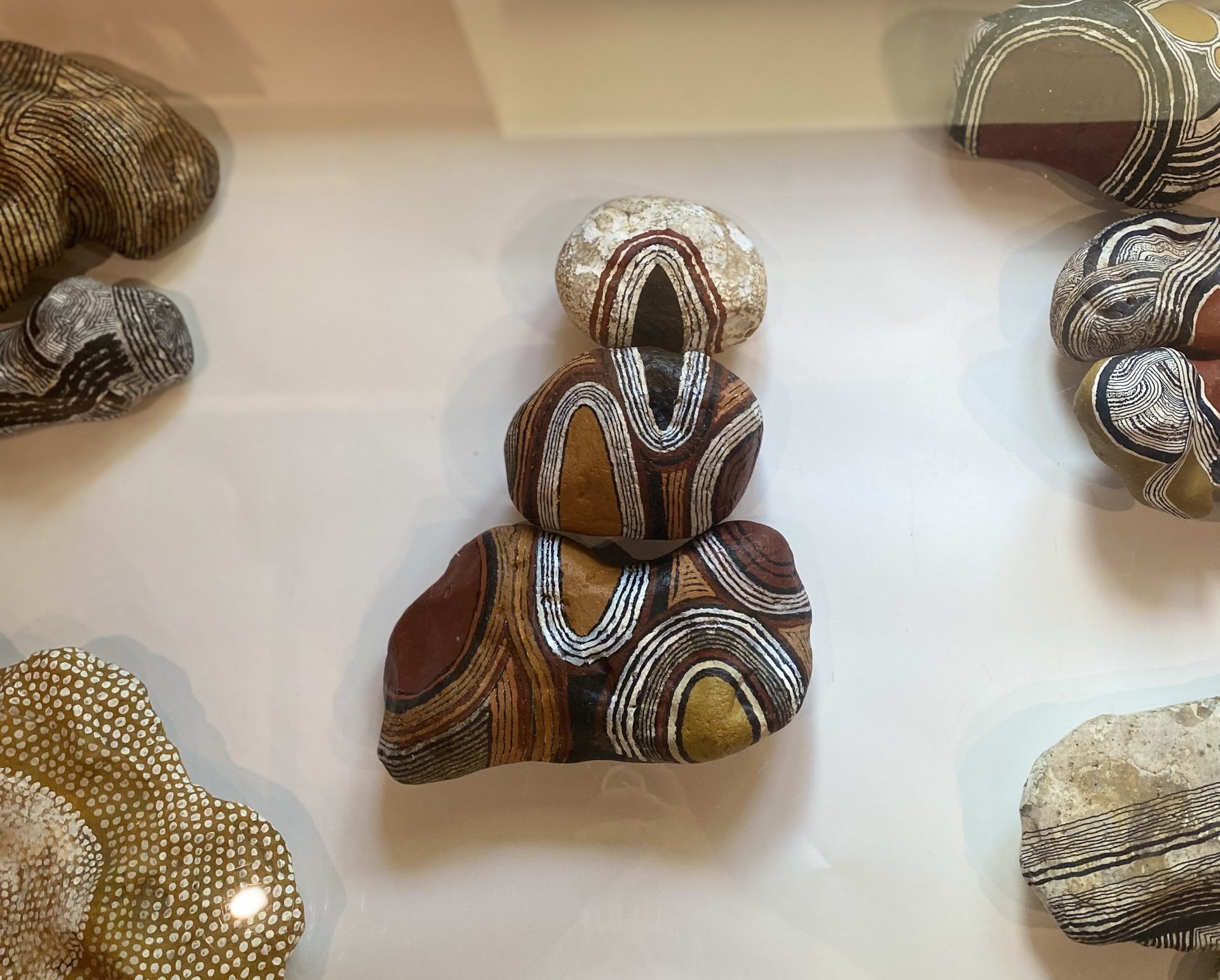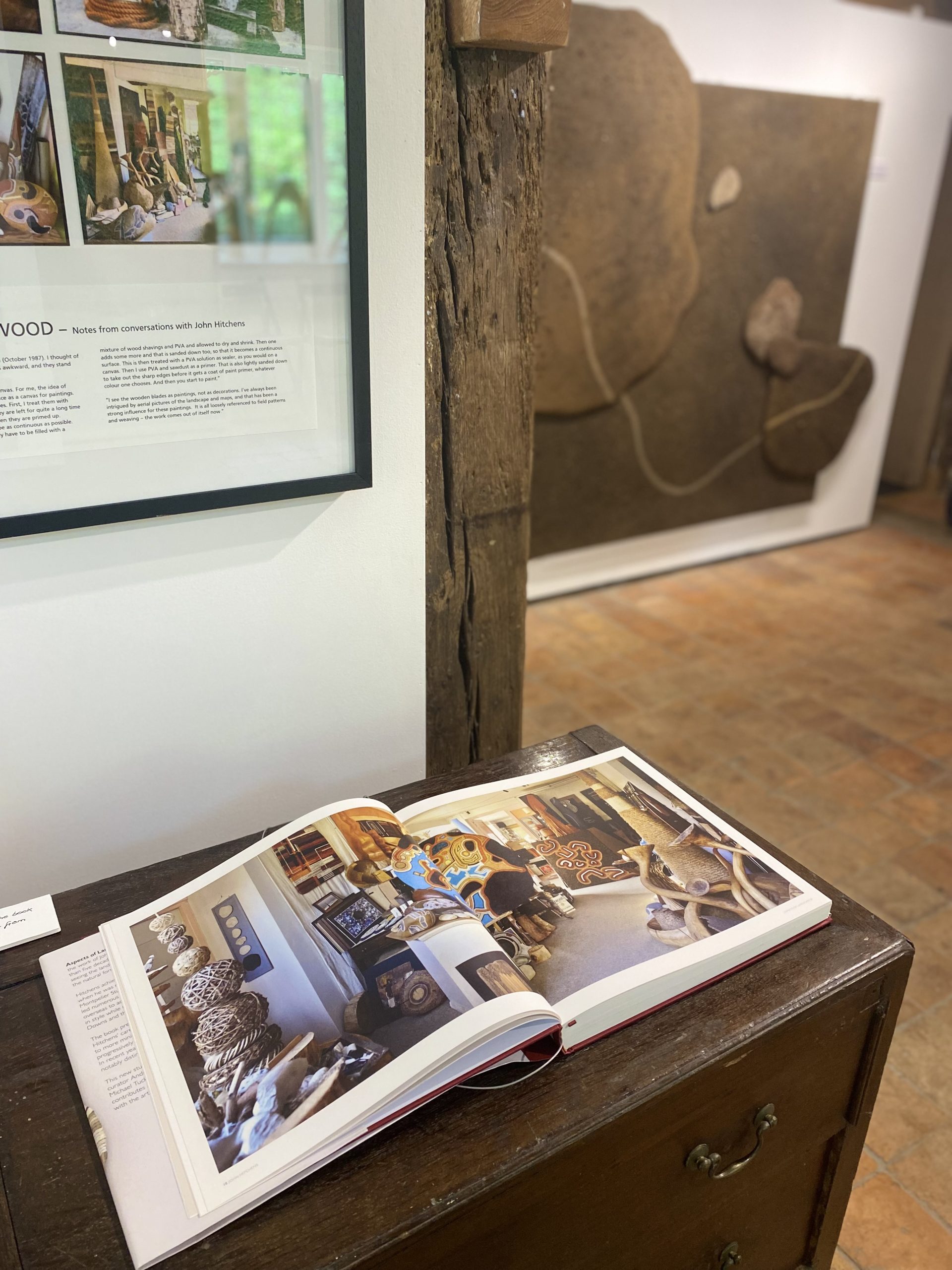‘Wood – Sand – Stone’ is on display at the Weald and Downland Living Museum, Singleton near Chichester until 30th October 2023, open daily 11am – 3pm.
An exhibition of recent work by John Hitchens has just opened at the Weald and Downland Living Museum, near Chichester. It comprises a collection of his abstract work on wood, sand, and stone, exploring the local landscape through colour and pattern. I sat down with him at his studio near Petworth to discuss the exhibition and the intention behind these works.
Connection to not just the landscape, but the Sussex landscape, is central to John’s oeuvre and the Weald and Downland Museum is a particularly apt environment in which to show his work. The buildings are hundreds of years old and the museum houses over 1000 years of Sussex history, integrated into the background of the Sussex Downs, gardens of wildflowers and a duck pond. The function of the museum is to be a centre of Sussex heritage, so John’s works feels at home here. The room, in a building whose earliest elements date from the 16th century, it has low ceilings but it still manages to feel spacious. It is uncluttered, the works have space to breathe, and with that each one speaks more loudly, more clearly. The room itself parallels the work physically. Wooden beams on the ceiling play with the John’s painted wooden uprights. The terracotta flooring harmonises with his warm brown tones. Outside the gallery you are situated within the downland landscape that John paints. Outside plays with inside; wood and stone are encased in wood and stone.
The pieces themselves are simple, quiet musings on the natural world. Earthy tones of brown and red are inspired by his wife Ros’ weavings. They are fully abstract works painted on pebbles, wooden uprights carved from tree branches, or canvas covered with sand. They have the look of aboriginal Australian art but this is incidental. Similarly based on the land but arising from John’s observations from his home in the South Downs rather than the sun-baked planes of down under. Dots and lines are like the ploughed ruts of a field seen from above, or layers of rock formed atop one another. They echo snail trials, ancient stone circles, or cut stems. Rough textures of bark or sand play with smooth stones and fluid lines. They invite the viewer to spend time with each unique piece and notice how shapes and colours interact. We are able then, to see with the same careful eye, the same considered attention, with which John sees the world.
To anyone who knows John’s earlier work these pieces seem to be something of a contrast. However, they are not a massive sea change from the atmospheric, hazy landscapes from the 1960s to 1980s displayed at Moncrieff-Bray Gallery. His work has been on an exploratory journey over the course of a lifetime. John has arrived at this style of abstraction through a continuous desire to question, to expand, to try new things and follow new ideas. Hailing from a family of painters, no mention of John’s name is ever far from his father Ivon’s or Grandfather Alfred’s. Both successful painters, John has been building on, or rather alongside, their reputations his whole career. As a young artist in his twenties he painted landscapes that are beautifully simple abstractions, impressionistic renderings of mountainous or wooded scenes such as North Uist, Tide and Distant Hills from 1969 or Loch Torridon, Drifting Rain, 1971. Then, feeling trapped beneath the vast blue expanse, he began pushing the sky out of the frame. These works from the 1970s and 80s of woodlands on long, thin canvases, particularly garnered comparisons with his father’s work. John was keen to point out the differences He came to this style through his own experimentation rather than by following some formula. As he said to me, there is no satisfying those people who seek the comparison with his heritage line: either he is following, even copying his family, or rebelling against them. He spoke very casually about the relationship with his father’s work, recognising it as ‘a line’ that people use, but nothing more. To him, he was neither for nor against his family, but alongside and in between.
Indeed, there is an ease with which John paints, and speaks about his paintings. He is unpretentious. His route into abstract works was one of simple exploration, asking questions and following the answers through fully. When I asked what drew him towards abstraction, he took a beat and simply said, ‘It just happens.’ He experimented with different ideas and abstraction is what stuck, but all follows from what came before. He has forged a path of progression, continually taking steps forward based on a logic of looking. He notices the smallest details and considers them with an almost meditative approach, building up in layers like strata. It is almost like nature itself, growing from what was there before, always part of something else, layering on top of one another like the strata of rock echoed in John’s work.
He stressed to me the importance of having fun as an artist. His practice is instinctive and is very much about trusting in one’s own ability. It is about taking every idea you can to its conclusion and putting all your effort into it. However, he paints because he loves it. It is serious work, yes, but as he told me, ‘It’s serious fun. You shouldn’t be painting if you don’t enjoy it.’
I have been trying to get to the heart of what John’s work is about, to find that central nexus that makes everything fit into place and I must admit I have been struggling. It seems to me that there are contradictions in what John does. His work has been compared with various other artists or movements (Ivon, aboriginal art, land art) but he is not aligned with any other group or genre. He called himself a ‘loner,’ not feeling the need to be part of a group or to share ideas, or to talk intellectually about his art.
Known as a landscape artist, he also has a deep interest in space and science-fiction. As a child he loved sci-fi stories (‘before it became too clever’) and he enthusiastically spoke to me about what a miserable place Mars would be to live on. He showed me paintings on stones with his recurring dots which represented galaxies. Indeed, he is interested in the universal. Sussex is crucial to what he paints, but it is not because of some essence he found here, but because it was what was in front of him, what he knew, and it had everything he needed. He had no reason to look further. The comparison with aboriginal art seems to come from a shared ability to look closely at the natural world, a shared colour palette, and a shared command of pattern. But each came to these features by different roads, and to different ends. Put simply, John Hitchens does not fit into a box. He is an explorer, and a wonderer, unbound by genre, intellectualism, or marketability. He paints simply because there is nothing else he could imagine himself doing.
This exhibition captures that sense of immediacy and freedom. It is accessible to anyone. It is purely visual; you do not need to know any context to appreciate the works. They are primal, tapping into our desire to see patterns and doing so in colours that are innate and instinctive. At its heart the exhibition is about opening ideas and new ways of looking.
Like all of us, John contains multitudes but if he were to be distilled down, he would be, in his own words, a ‘meditative explorer.’ That simple ethos of asking questions and being at peace with the world is what makes these works, and this exhibition, so quietly profound.
‘Wood – Sand – Stone’ is on display at the Weald and Downland Living Museum, Near Chichester until 30th October 2023, open daily 11am – 3pm.










